John Mayer’s guitar rig has changed over the years and he has built up a large collection of guitars, amps, and pedals. If you want to learn to sound like John Mayer, there are some key lessons you can learn from the gear he uses.
In this guide, I’ll go through John Mayer’s guitar rig and explain each part and how it contributes to his guitar tone.
By the end of this guide, you’ll be able to use this information to get closer to John Mayer’s tone.
John Mayer’s Electric Guitars
While John Mayer has a massive guitar collection and has played a wide range of guitars over the years, he’s definitely a strat player. If you want to get a John Mayer guitar tone, you’ll want a strat in your hands.
While John Mayer played basic Squier and Fender Stratocasters in the early days, the Stevie Ray Vaughan Signature Strat he bought in 1996 stands out.
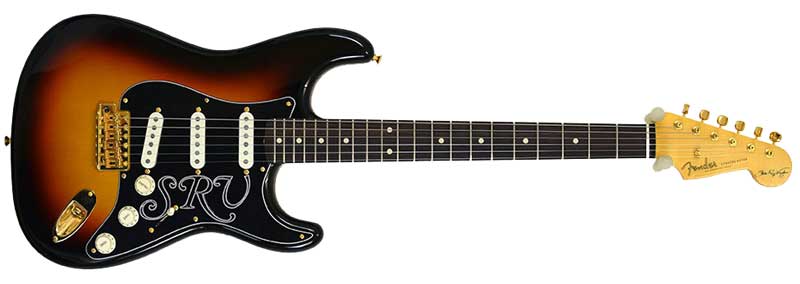
He famously saved up for this guitar by working at a gas station and traded a 12-string guitar and a distortion pedal for it (plus cash).
John Mayer’s signature guitar (covered later) is based on this guitar, so it has clearly had a big influence on his playing. Over the years, John has used a few different SRV signature models on tour.
John toured with various other strats including a Jimi Hendrix Monterey Stratocaster in 2003.
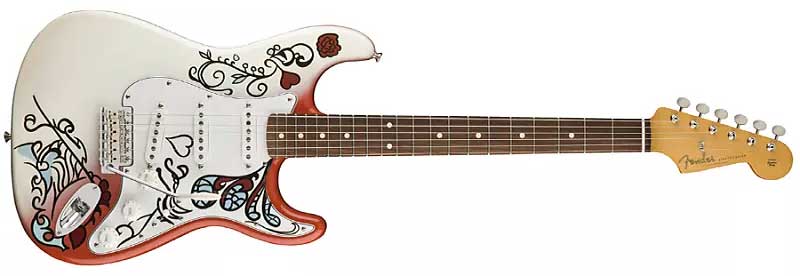
We could go through a long list of various strats John Mayer has played as well as some non-strat guitars, but I’ll focus this section on his main guitars.
In 2004, John Mayer started playing “The Black One” – a signature Strat built for him by the Fender Custom Shop. The guitar was reliced because Mayer felt that removing the lacquer helped the guitar resonate.

This Strat was the main guitar used on the Continuum album and heavily used on tour.
In 2015, John Mayer switched from Fender to PRS. Fender wouldn’t build the guitar he wanted, so he looked elsewhere. Over the next few years, John and Paul Reed Smith worked on building a signature model to John’s specifications.
In 2018, they release the PRS Silver Sky.

This guitar was heavily mocked online when it was released due to the fact that it’s visually a Strat with a PRS headstock.
I remember when it launched and John Mayer and Paul Reed Smith both spent a lot of time in interviews and streams defending the decision to build this guitar. When you consider John Mayer’s love for Stratocasters, it should be no surprise that he asked PRS for a Stratocaster-like guitar.
The Silver Sky was relentlessly mocked until people started picking one up. While it looks exactly like a typical Stratocaster, it feels different in your hands.
Small changes in fretboard radius, neck shape, fret size and shape, and body contours can have a big impact on how a guitar feels to play.
Some guitarists pick up the Silver Sky and prefer a modern Fender Strat, while others prefer the Silver Sky. The Silver Sky isn’t an improved Stratocaster, it’s just different.
Here are some key facts about the PRS Silver Sky:
- Alder Body
- Bolt-On Maple Neck (learn about neck joints here)
- Rosewood or Maple Fretboard
- 22 Frets
- 25.5″ Scale Length (learn about scale length)
- 7.25″ Fretboard Radius (learn about fretboard radius here)
- Steel Tremolo Bridge with Vintage Style Locking Tuners
- 635JM Single-Coil Pickups
The PRS Silver Sky is built in the PRS factory in Maryland, USA. Find out more about where PRS guitars are made and the differences between each series in this guide.
The Silver Sky comes in a nice range of colors as well as a few models. The newest Limited Edition Silver Sky has a polychromatic finish that changes color depending on light conditions (Lunar Ice model shown below).
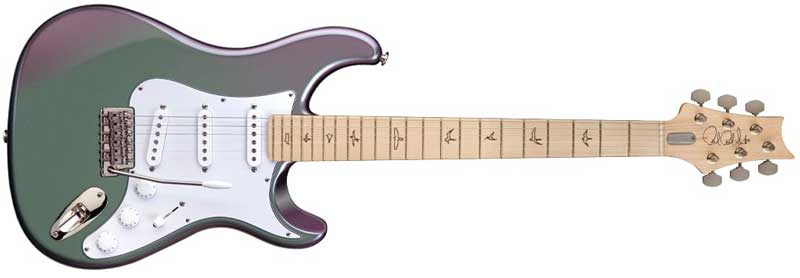
For John Mayer, the Silver Sky has all the small tweaks he wants to make the guitar feel as good as possible. But whether you prefer a Fender Strat or the Silver Sky depends on your own preferences.
The above link is an affiliate link. If you do buy a Silver Sky, consider buying it through the above link. I will earn a small commission at no cost to you, so it’s a great way to support this site so I can write more guides like this one.
PRS Silver Sky SE
After a long wait, PRS are finally selling PRS Silver Sky SE guitars. The SE is a more affordable version of the Silver Sky and is worth checking out if the price of the regular Silver Sky is too high for your budget.
Here are the current color options for the PRS Silver Sky SE as at 2022:

The Silver Sky SE has been demanded by a lot of guitarists for a very long time, so don’t be surprised if stores have low stock. My local guitar store instantly sold out of all SE models and has a large backorder, so they’ve been incredibly popular.
Find out how PRS SE guitars compare to other models in this guide.
John Mayer’s Acoustic Guitars
John Mayer has played a variety of Martin acoustic guitars over the years. Many were limited-production models that sold out immediately such as the popular Martin OM-28JM John Mayer signature edition back in 2002.

Only 404 guitars were produced, which is why second-hand models sell for insane prices.
Other limited signature models sold for eye-watering prices, such as the Martin D-45 JM signature model.
Only 45 of the Martin D-45 JM were produced in 2018 and had a price tag of $14,999.
Alternatively, you can currently buy the Martin OMJM John Mayer signature model which sells at a substantially lower price.

The Martin OMJM is very similar to the OM-28JM in features and style but far more affordable.
When talking about acoustic guitars, ‘OM’ stands for Orchestra Model. The main difference between a Dreadnought acoustic guitar and an Orchestra Model is the depth of the guitar’s body.
OM guitars have a shallower body, which means the guitar can sit closer to you as you play. They don’t feel as bulky as Dreadnought guitars while offering the same scale length (learn about scale length and why it’s important in this guide).
John Mayer has played a variety of OM and Dreadnought guitars over the years, so if you’re looking at buying one, make sure you try both types out to get a feeling for which may suit you best.
John Mayer’s Guitar Strings
John Mayer uses Ernie Ball Regular Slinky strings on his electric guitars. On his Black strat, he uses 11 gauge strings, while using 10s on his other guitars.

Check out the Ernie Ball Regular Slinky strings here at Amazon or Sweetwater.
On his acoustic guitars, John Mayer uses Ernie Ball Acoustic 2146 Earthwood Medium Light strings. Different gauge strings are likely used on different models, but .012 – .054 gauge is the most common.

Check out the Ernie Ball Earthwood Medium Light strings here at Amazon or Sweetwater.
It’s also worth mentioning that if you buy his Martin OMJM signature acoustic guitar, it will come with Martin Authentic Acoustic Lifespan 2.0 strings installed from the factory.

Note: the type of strings you use can make a big difference in how a guitar feels to play. Even if you’re a die-hard John Mayer fan, the type of strings he uses may not suit you. Learn more about finding the right guitar strings for you in this guide.
John Mayer’s Guitar Picks
For a very long time up until around 2015, John Mayer used Jim Dunlop Tortex .88mm guitar picks (the green ones).
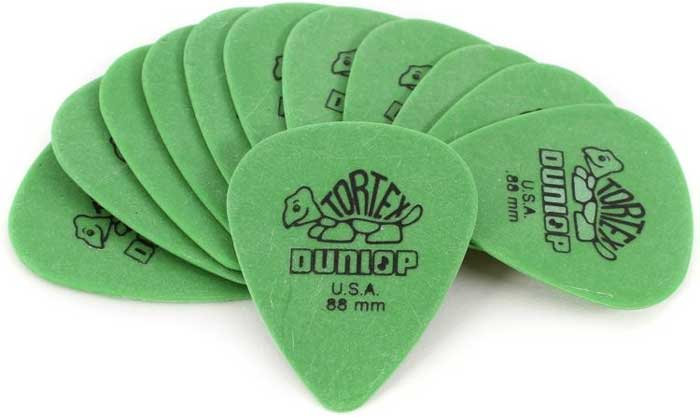
Around 2015 onwards, he switched to using Pickboy Vintage Pick Rainbow Celluloid .75mm picks:
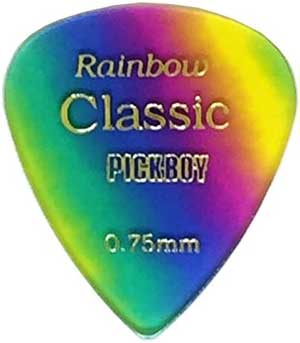
While guitar picks do have some impact on tone and the attack on each note, I highly recommend finding a pick that suits you. Just because John Mayer uses the above guitar picks, doesn’t mean they’re the best picks for you. Small changes in pick thickness, shape, or material can feel very different to play.
The best advice I have is to buy a variety pack of guitar picks and spend time playing with each one until you find the right pick for you. Check out this guide on guitar picks to learn more and for links to variety packs.
The truth is you can get close to a John Mayer guitar tone with any pick, so you may as well find a pick that feels comfortable to you.
John Mayer’s Guitar Amps
John Mayer has used a wide range of guitar amps over the years, so it can seem confusing at first as to what type of guitar amp you should get if you want to get a John Mayer tone.
He’s used a variety of vintage Fender amps, Dumble amps, and even a Fractal Audio Axe-FX III for some live performances (that surprised me!).
Another interesting point about John Mayer’s guitar amps is that over the years, he would use a multi-amp rig when performing live with different combinations of amps.
For example, in the below photo, the left amp head is a Dumble Steel String Singer, and the right amp head is John Mayer’s signature Two-Rock. These amps are very similar, but other times he would combine very different amps in his live rigs.

This means there isn’t one specific amp that captures what it means to get a John Mayer tone. The fact that he usually blends different amps together to create his tone and that he often changes what amps he uses tells you that you have a lot of choice in what amp you can use and still get his tone.
I’ll go through two of his signature amps to give you an idea of what features to look for in any amp if you want to get a John Mayer tone.
John Mayer’s Two-Rock signature amp was based on an earlier Steel String Singer amp he used to play. He had the lead channel removed as well as modified to increase the headroom.

This single-channel 100-watt tube amp was limited to 25 models, so don’t expect to rush out and get one any time soon.
When John partnered with PRS, in addition to creating the Silver Sky, they also worked on a signature guitar amp.
The PRS J-MOD 100 John Mayer Signature tube amp was designed to be an all-around go-to amp for John for touring and recording.

This is a single-channel tube amp with a switchable gain stage for lead tones. It includes an effects loop (learn about effects loops in amps here), 4x 6L6 power tubes and 4x 12AX7/ECC83S preamp tubes.
Here’s a close-up of the amp head so you can get an idea of what controls John prefers to have on his amps:

It should be clear from the above photo how basic the controls are compared to other amps. While the amp you use has a massive impact on your guitar tone, the above photo should give you an idea of how important John’s pedals are in helping to shape his tone.
Choosing an Amp
John Mayer has jumped around from amp to amp over the years so much that there’s no one amp that definitely covers his tone.
In a way, this is good for you because it means you don’t need to buy a specific amp – you have plenty of amps to choose from.
The key to getting a John Mayer guitar tone is to use a clean tube amp with a lot of headroom. Then you can use drive and boost pedals to saturate your tone when needed (covered later).
John uses single-channel amps, so you don’t need to look for anything with lead or drive channels.
Yes, you could buy John Mayer’s signature PRS amp, but keep in mind that is a 100-watt beast. If you’re looking for an amp for home use, that may be overkill.
Any small Fender tube amp will be perfect as they produce fantastic clean tones for home use. John has used so many different Fender amps over the years, so if you find any Fender amp you like the sound of, go for it.
Something like a Fender Blues Junior, Pro Junior, or Hot Rod Deluxe (shown in order below) would be ideal amps for a John Mayer tone.

Check out different Fender amp models here (link to Amazon) or at Sweetwater here.
John Mayer even recommended using a Fender amp when he talked about his move to PRS and the Silver Sky.
Here’s what he had to say about what amp to use with the Silver Sky:
“I want to see people play Silver Sky through the Fender amp. Because that’s what makes the sound. I was watching someone play through like a Victory amp and going, ‘Just play through a Fender!’
So if you want to get a John Mayer guitar tone, play a Strat or a Silver Sky through a Fender amp.
John Mayer’s Guitar Amp Settings
If you want to get a great John Mayer guitar tone, you’re probably wondering what amp settings he uses.
If you search online for John Mayer amp settings, you’re not going to find any useful information. A lot of people try to find in photos what his amps are set to, but even if you matched his exact amp settings, it’s not going to make much difference.
The fact that John Mayer has used such a wide range of guitar amps over the years and that he regularly combines multiple amps at once should tell you that searching for amp settings he uses is a waste of time.
The settings he likely uses on a Fender amp will be completely different than what he uses on a Dumble amp or his PRS.
In this Guide to Guitar Amp Settings, I explain why searching for amp settings and presets online is a waste of time. I also explain everything you need to know about dialing in a great guitar amp tone without needing to rely on presets.
Read the above guide if you want to learn how to dial in a John Mayer tone using your guitar amp.
John Mayer’s Pedalboard
The guitar pedals John Mayer uses plays a crucial part in his tone. As explained earlier, John uses clean single-channel guitar amps. It’s his pedals that shape his tone and allow him to dive into a wide range of tones.
As you might expect, John Mayer’s pedalboard is constantly changing. It seems as if most of the pedals completely change in every tour.
The below photo shows how complex his rig can be for his solo tours:

While this looks complicated, the basic idea is that all of the pedals on the left and right pedalboards feed into the middle foot controller. The middle foot controller provides John with an easy way to toggle different effects or toggle multiple pedals at once as he likes.
You can learn more about MIDI Foot Controllers in this guide to see if you would like to run a similar setup (even if you don’t have as many pedals as John has).
I’ll go through two examples from his Dead & Company pedalboards to give you an idea of the core pedals and effects you might want to get if you want to build your own John Mayer guitar rig.
The Dead & Company pedalboards seem to be simpler than his solo tour pedalboards, so it’s a good way to understand the basics of his rig.
By comparing his pedalboard over time, you can get an idea of which pedals are interchangeable and which ones are crucial to his rig.
2016 Pedalboard
The below photo shows John Mayer’s pedalboard during a 2016 tour. It may look overwhelming, but I’ll break down each pedal below.

Here are the above pedals as numbered:
- BOSS OC-3 Super Octave (Amazon or Sweetwater)
- MXR M-107 Phase 100 (Amazon or Sweetwater)
- Ibanez TS-10 Tube Screamer Classic
- Way Huge Aqua Puss Analog Delay (Amazon or Sweetwater)
- Strymon Flint Tremolo & Reverb (Amazon or Sweetwater)
- Pete Cornish Tape Echo Simulator
- BOSS TU-3 Chromatic Tuner x2 (for Acoustic Guitar) (Amazon or Sweetwater)
- Ernie Ball 6180 VP JR Volume Pedal (Amazon or Sweetwater)
- Real McCoy Custom RMC8 Guitar Eqwahlyzer Wah
- BOSS TU-3 Chromatic Tuner (for Electric Guitar)
- Keeley Katana Pre Amp
- Klon Centaur
- Electro-Harmonix Q-Tron Plus (Amazon or Sweetwater)
- Strymon OB.1 Optical Compressor and Clean Boost
It goes without saying that this is a lot of pedals. Some of these pedals are far more important than others, so don’t feel as if you need to buy 14 pedals to be able to sound like John Mayer.
2019 Pedalboard
The below photo shows John Mayer’s pedalboard used in 2019. You’ll notice some of the pedals stay the same as the previous pedalboard while others have changed.
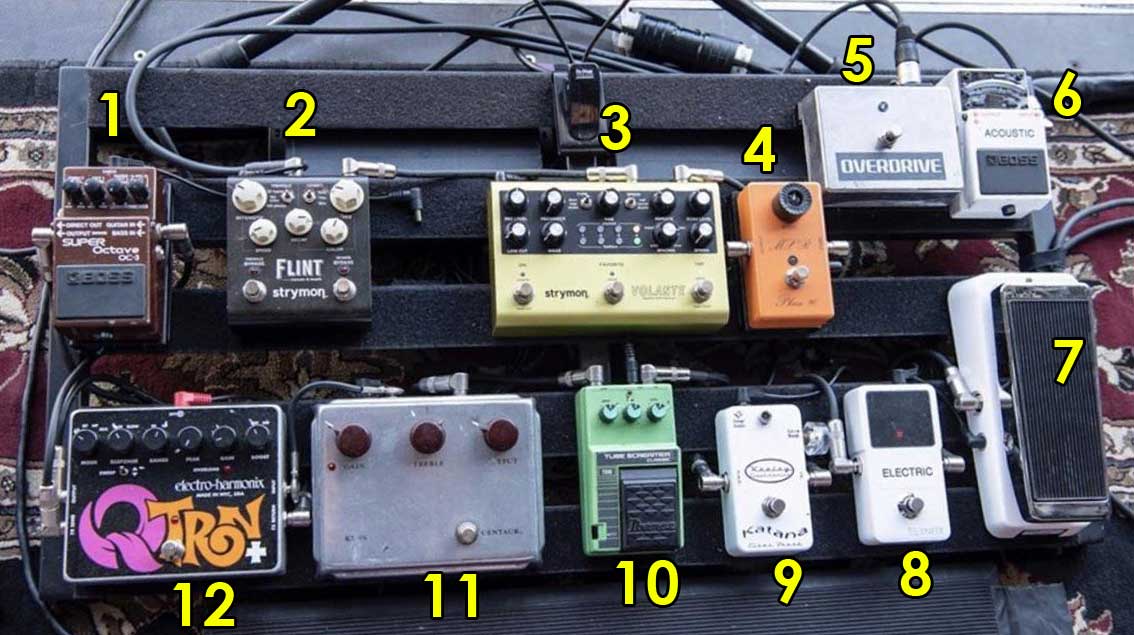
Here are the above pedals:
- BOSS OC-3 Super Octave (Amazon or Sweetwater)
- Strymon Flint Tremolo & Reverb (Amazon or Sweetwater)
- Strymon Volante Magnetic Echo Machine (Amazon or Sweetwater)
- MXR M-101 Phase 90 (Amazon or Sweetwater)
- Footswitch for Guitar Amp
- BOSS TU-3 Chromatic Tuner (for Acoustic Guitar) (Amazon or Sweetwater)
- Xotic Effects XW1 Wah Wah (Amazon or Sweetwater)
- TC Electronic PolyTune (for Electric Guitar) (Amazon or Sweetwater)
- Keeley Katana Pre Amp
- Ibanez TS-10 Tube Screamer Classic
- Klon Centaur
- Electro-Harmonix Q-Tron Plus (Amazon or Sweetwater)
This time there are fewer pedals, but many of the pedals have stayed the same compared to the 2016 pedalboard. Let’s go through some of the more important pedals in more detail.
Comparing Pedalboards
Comparing the above two pedalboards is a great way to learn about how John uses pedals and how his preferences change over time. Look up any photos of his pedalboards and you’ll see random pedals showing up, then disappearing in other photos.
Here are a couple of the pedals that were changed out between the 2016 and 2019 pedalboards and a few thoughts on each one:
MXR Phase 100 (2016) and Phase 90 (2019): while John changed to a different model in the 2019 pedalboard, there isn’t much difference between the two models. Either pedal will produce similar sounds.
Pete Cornish Tape Echo Simulator (2016) and Strymon Volante Magnetic Echo Machine (2019): John is known for experimenting with different echo effects and other pedalboards show him using other echo simulators.
My guess is that he switches out the type of echo and delay pedals based on what songs he wants to play. His preferences on echo may change over time or he may just like mixing things up with different pedals.
Now that we’ve had a look at some of the interchangeable pedals, let’s look at some of the core pedals that form John Mayer’s pedalboard.
Keeley Katana Pre Amp
The Keeley Katana Pre Amp is a crucial part of John’s pedalboard and you can find it (or a similar boost pedal) on pretty much any of his pedalboards.

Having a boost pedal combined with a clean tube amp goes hand-in-hand. A boost pedal is designed to push the tubes harder while minimally changing the tone.
Boost pedals are great for solo parts or any sections when you want to squeeze a bit more out of your amp without changing your tone.
You can definitely buy the Keeley Katana boost pedal if you want, but any other boost pedal will achieve similar results.
The Xotic EP Booster Mini and the TC Electronic Spark Mini are both very popular boost pedals to consider.
Tubescreamer
If you want to build a pedalboard inspired by John Mayer, you will definitely need a Tubescreamer.
While he has used a wide range of Tubescreamers (both original models and clones), even he says they all do basically the same thing.

All Tubescreamer clones and boutique models are based on the same Tubescreamer circuit, but each one usually puts a slightly different spin on the tone.
The above two pedalboards show him using a TS-10, but in other tours, he has used a TS-808 (both vintage and Keeley mod), Fulltone Fulldrive 2, TS9DX, JHS Bonsai, and countless others.
The key point to keep in mind is that while you should consider getting a Tubescreamer if you want to get a John Mayer tone, you can choose from a wide range of Tubescreamer-based pedals and find one that suits you best.
The below photos show the settings John Mayer uses on his TS-10 at three different points in time:
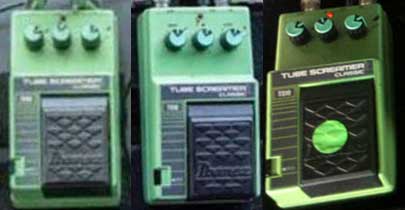
You can see that sometimes he has the knobs set all straight up and other times he turns the Drive and Level knobs up higher.
He likely adjusts the amount of gain and level depending on what guitar amp he’s using. The way a Tubescreamer interacts with an amp will vary depending on the amp.
So if you buy a Tubescreamer, play around with the settings to find what works for you and your rig. Don’t blindly use the above settings because they may not suit your rig.
Klon Centaur
If you haven’t heard of the Klon Centaur before, it’s an iconic pedal with a wild history. I’ve dedicated an entire Guide on the Klon Centaur here where I talk about the crazy prices they sell for and why they’re so sought-after.
The Klon is almost always on John Mayer’s pedalboard, so it’s a crucial part of his tone. The Klon Centaur doesn’t color your guitar tone in the same way as a Tubescreamer, but it does color it more than a boost pedal.
By having a boost pedal, a Tubescreamer, and a Klon on his pedalboard, John is able to tweak and shape his tone in various ways to suit different songs and tones. Having all three is a core part of John Mayer’s pedalboard.
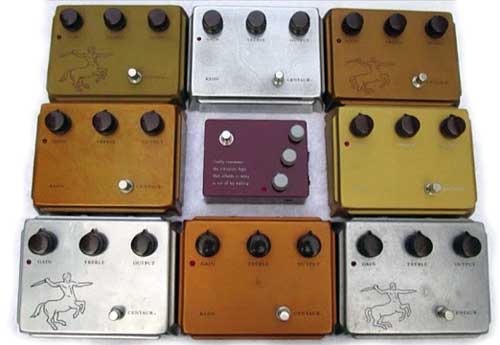
The above photo shows different variations on the original Klon Centaur (and the newer Klon KTR).
While you probably don’t want to spend $4000+ to buy a real one, there are plenty of affordable clones that sound just as good as the real pedal. You can even build your own Klon clone from a kit as shown in this step-by-step tutorial.
If you want to get a guitar tone similar to John Mayer, then grab yourself a Klon clone within your budget level.
Here’s a close up of the Klon pedal settings from the two earlier guitar rigs:

You can see that John keeps the gain quite low while boosting the treble. If you try a Klon (or any clone), you’ll notice that this is quite a low gain level.
The Klon sounds quite clean until you really crank the gain knob, so this is an example of how John Mayer uses this pedal as a way to shape his tone. When combined with the boost and Tubescreamer, he has three different options of adjusting the saturation and gain in his tone.
Learn more about the Klon Centaur and popular clones here.
Q-Tron
The EHX Q-Tron Plus is an envelope filter that John Mayer has been using since around 2013. Before the Q-Tron, he used an AdrenaLinn by Roger Linn Design.
You can hear him use it extensively in songs such as I Don’t Trust Myself (With Loving You) and Going Down The Road Feeling Bad.

An easy way to think of an envelope filter if you’ve never used one before is that it’s kind of like a wah pedal that you control by how hard you pick the strings.
If you pick the strings hard, it’s like rocking a wah pedal all the way back and forth. If you pick the strings gently, it’s like gently rocking the wah forward, then back again.
Envelope filters are covered in detail in my Guitar Effects Course if you want to learn more about them.
Here is a close up of the Q-Tron pedal settings John Mayer uses:

You can see that in both tours he has kept the settings almost identical. So if you really want to recreate the tone you hear when he uses the Q-Tron, use these settings.
Here are the settings John Mayer uses on his Q-Tron Plus:
- Mode: LP
- Response: Fast or set it half-way between Fast and Slow
- Range: LO
- Peak: 7 – 8 o’clock
- Gain: 8 o’clock
- Boost: OFF
- Sweep: Up position
If you listen to any performance where John uses the Q-Tron Plus, you might notice how subtle it is. The Q-Tron can produce some wild sounds, but John Mayer uses it as subtle as possible.
While you can find a Q-Tron on pretty much any pedalboard you see him use, whether you decide to buy one or the smaller Q-Tron Micro depends on whether you want to play the songs that feature it or not.
Wah
John Mayer always seems to have a wah pedal on his pedalboard. While he occasionally uses a wah in his music, you see him use it all the time when playing Jimi Hendrix covers.
As you can see from the earlier two pedalboards, the model of the wah he uses constantly changes.
The Xotic Effects XW1 Wah was the most recent wah I’ve seen on his pedalboard (2019).

You can see on the side of this wah pedal that it includes some EQ controls and two other knobs to dial in different wah settings. The other wah pedal in the 2016 pedalboard also included EQ controls, so it’s clear that John likes to be able to dial in specific settings for his wah.
Most of the popular wah pedal models don’t include EQ controls, but many do offer EQ and other parameters you can tweak.
It’s worth mentioning that John uses his Q-Tron pedal almost like a wah pedal. The settings he uses makes it sound very similar to an ‘auto-wah’, which is a wah pedal that automatically sweeps back and forth based on how hard you pick the strings.
So if you don’t like the idea of buying the Q-Tron as well as a wah, it’s possible to use either one to achieve similar results. If you don’t want to get a Q-Tron, you can use a wah pedal in those songs and with some practice, you can produce a similar-sounding tone.
Check out some of the best wah pedals in this guide.
If you want to hear some interesting ways of using a wah pedal, check out this guide on songs using a wah pedal.
Strymon Flint Tremolo & Reverb
Reverb is an important part of John Mayer’s guitar tone. Sometimes he uses his guitar amp’s built-in reverb and other times he uses a pedal such as his Strymon Flint Tremolo and Reverb pedal.

The Strymon Flint is basically two pedals in one. The left footswitch enables a tremolo and the right footswitch enables a reverb.
This pedal is modeled after vintage gear, as you can see from the different tremolo and reverb models on the pedal. John Mayer loves vintage sounds, so it’s no surprise that he uses the Strymon Flint for his reverb.
Here are three photos of John Mayer’s Strymon Flint across three different pedalboards.
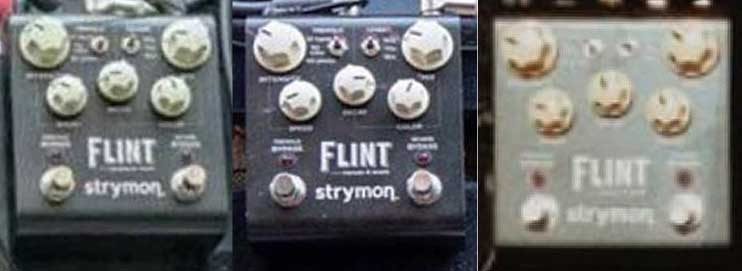
Here are the settings John Mayer uses on his Strymon Flint pedal:
- Intensity: 10 o’clock
- Tremolo toggle: either ’61 harm or ’63 tube
- Reverb toggle: 60s
- Mix: 9 – 10 o’clock
- Color: 12 – 1 o’clock
- Decay: changes wildly
- Speed: 8 – 10 o’clock
It’s interesting that almost every knob is identical across three separate tours except for the Decay knob. He may change this based on the venue or it may change depending on songs.
Remember that the above pedal settings should only be used as a starting point. You should adjust your pedal’s settings based on the rest of your gear and what type of tone you like.
Just because John Mayer sets his pedals a certain way doesn’t mean you should use the exact same settings. If he picked up your guitar and played through your rig, he would likely adjust the pedal settings to suit the rig.
So take your time experimenting with the pedal to work out what settings suit you and your rig best. The above settings should only be a starting point to play around with.
What I Like About John Mayer’s Guitar Rig
Taking a closer look at a guitarist’s rig is a great way to learn how they think about guitar and music. If you’re interested in learning more about how John Mayer thinks about guitar and his music, it’s worth taking a closer look at his rig as we have done in this guide.
Here are some aspects of John Mayer’s guitar rig that I find interesting:
Stacking Gain Pedals
I really like how John Mayer uses three different pedals to shape his tone. He uses a boost pedal, a Tubescreamer, and a Klon Centaur as three different ways of boosting and shaping his tone.
This is a very different approach compared to most other guitarists. Most guitarists will use their amp to produce their drive tone, then maybe combine that with a pedal if they want more gain.
John Mayer sticks to using a clean tone (many of his amps don’t even have a drive channel) and uses his pedals to push his amp higher in three different ways.
The advantage of stacking gain pedals is that you can smooth out your tone in ways that you can’t do with a single pedal. Combining the Tubescreamer with the Klon gives John plenty of tonal options.
In your own rig, you might want to try combining two different drive pedals. Compare two gain pedals stacked together against one gain pedal and you’ll see why John prefers his setup.
I cover gain stacking in Part 2 of my Guitar Effects Course. If you’ve never tried gain stacking before, I highly recommend trying it out.
Evolution of Gear
Some guitarists use the same pedals and gear over their entire career. If you look at my Guide to Tom Morello (Rage Against the Machine, Audioslave), he’s been using the same few pedals for decades. This works for some guitarists. If you find a combination of gear that works for you, there’s no need to change it up.
John Mayer takes a different approach. He’s constantly trying out different amps, guitars, and pedals and adjusting his rig based on his evolving preferences.
The fact that he switched from Fender to PRS is a great example of how he isn’t tied down to any specific gear.
It might be hard for us to keep track of these changes, but it shows that you don’t need to buy specific gear to get a John Mayer sound.
As long as you have a few key ingredients (covered later), you can get close to his tone.
How to Sound Like John Mayer
There are a few things you need to sound like John Mayer. You need to play a Strat or a Strat-like guitar, into a clean amp with a high headroom, and use one or more of the drive pedals he uses.
Let’s go through the core components that make up John Mayer’s sound. You can always add more gear to get closer to his tone, but the below gear is the core of his sound.
Guitar
If you want to sound like John Mayer, you’ll find it much easier if you play a Stratocaster or some sort of Strat clone.
There have been plenty of times when John has played other guitars using humbuckers and non-strat shapes, so you don’t have to play a Strat, but you will find it far easier to match his sound with a Strat in your hands.
What is important to keep in mind is that you don’t have to buy a Fender to sound like John Mayer.
While he has played Fender Stratocasters for most of his career, his switch to PRS shows that the brand doesn’t matter as much as the style of guitar.

This also means you don’t need to buy a PRS Silver Sky. If you can’t afford a high-end Fender Strat or a Silver Sky, don’t stress.
Any Strat-like guitar will be perfectly fine in helping you sound like John Mayer.
Grab yourself a Squier Strat if you’re on a budget and it might be all that you need.
Check out my review of the different Squier Stratocaster models here to learn more.
Amp
The key to sounding like John Mayer is using a clean guitar amp with high headroom.
John doesn’t use the gain channel on his amps and many don’t have gain channels, so you don’t need to shell out money for an expensive multi-channel amp. Any single-channel amp with a good clean tone will be great.
John does recommend to others using a Fender amp, so that’s a great starting point in searching for the right amp for you. As mentioned earlier, a small Fender Blues Junior combo amp or similar will be ideal for sounding like John Mayer.
Pedals
John Mayer uses a lot of pedals. Some of them are crucial for his main tone and many of them are only used for specific songs.
For example, it’s clear that the Q-Tron is important as it’s always on his pedalboard. But it’s only used in specific songs. If you aren’t interested in getting the tone you hear in those songs, you don’t need to get a Q-Tron.
On the other hand, you’ll probably want to copy the three gain pedals he uses as they form the core of his tone.
If you can, buying a Boost pedal, a Tubescreamer, and Klon Centaur clone will give you the same foundation for your tone as John Mayer uses.
If you want you can cut this down to only using a Tubescreamer. But having at least one more transparent boost or overdrive pedal gives you more flexibility.
Other effects such as delay, tremolo, echo, or wah can be added or removed to your pedalboard as you like. John Mayer switches out different pedals based on his current preferences, so they’re all interchangeable.
You can add any of these effects as you like or you can get yourself a multi-effects pedal so you can have all of these effects on hand whenever you need them. Even something like the small Line 6 HX Stomp can give you access to all of the sounds John gets from his various pedals.
Check out this comparison of Line 6’s multi-effects pedals to learn more about different options.
Reverb
Reverb is an important part of John Mayer’s sound. Sometimes he uses the inbuilt reverb in his amp. If your amp has inbuilt reverb (preferably spring reverb), use that to get closer to a John Mayer sound.
If your guitar amp doesn’t have inbuilt reverb or you don’t like the reverb sound, you can use a reverb pedal instead.
John Mayer uses a reverb pedal whenever his amp doesn’t have inbuilt reverb. He prefers to use spring reverb pedals to get the vintage reverb sound he had in his Fender amps.
Check out this guide on Reverb to learn about different options to consider.
Example John Mayer Guitar Rigs
John Mayer’s guitar rig changes from tour to tour, so it’s hard to give an exact example of what pedals and gear to buy if you want to copy his tone.
Here are three basic examples of an electric guitar rig you can use as a starting point for any gear you might want to buy.
Budget Guitar Rig
The basic idea with the below rig is to give you the essential components at a low cost. From this starting point, you can decide what other pedals you might want to add to your rig.
- Guitar: Squier Stratocaster (Squier Strat review)
- Amp: Fender Champion 20-watt (or any similarly priced Fender combos) (check it out at Amazon or Sweetwater)
- Drive Pedal: Ibanez Tube Screamer Mini (check it out at Amazon or Sweetwater)
With the above rig as your foundation, you can add a wah, Q-Tron Mini, delay, or any other pedal mentioned in this guide as you like.
Think about what pedals you might want to add based on your budget and what John Mayer songs you want to play. But even if you only use the above rig, it’ll give you a decent starting point.
Mid-Level Guitar Rig
If you want to set up from the above rig, you can either expand the pedals you use or upgrade some components.
Here is an example guitar rig at a more mid-budget level.
- Guitar: Fender Stratocaster (any model in your budget) (check it out at Amazon or Sweetwater)
- Acoustic Guitar: Martin OMJM (Sweetwater)
- Amp: Fender Blues Junior (check it out at Amazon or Sweetwater)
- Drive Pedals:
- Ibanez Tube Screamer Mini (check it out at Amazon or Sweetwater)
- EHX Soul Food (Klon Centaur Clone) (check it out at Amazon or Sweetwater)
- Other Effects: Line 6 HX Effects (check it out at Amazon or Sweetwater)
It might seem odd for me to suggest the Line 6 HX Effects, but the reason is simple. John Mayer uses a lot of effects, but many of them he only uses on a couple of songs. Instead of buying a stack of pedals that you may only use on rare occasions, getting a multi-effects pedal like the HX Effects gives you every effect you might ever want to use.
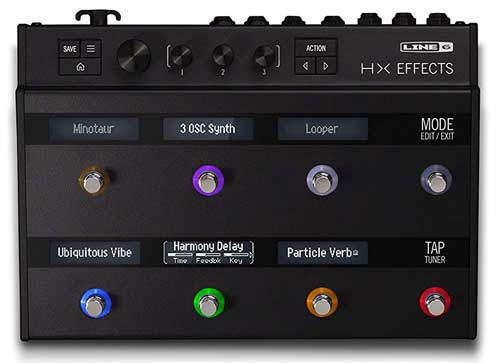
You’re able to access all of the effects John Mayer uses in one unit. This means if you can bring up any effect you need without having to buy separate pedals.
You can bring up a Q-Tron effect, an octave effect, echo machine, tremolo, phaser, delay, spring reverb, and countless more. You can even use the HX Effects for drive and boost effects because it includes a Klon Centaur model, a Tube Screamer mode, and various boost pedal models.
High-End Guitar Rig
The more money you have to spend, the closer you can get to the gear John Mayer uses. How closely you match the gear you buy to what he uses depends on what’s important to you and your budget.
- Guitar: PRS Silver Sky (check it out at Amazon or Sweetwater)
- Amp: PRS J-MOD 100 or any Fender tube amp you like the sound of
- Drive Pedals:
- Ibanez Tube Screamer (any model or clone you prefer) (check some options out at Amazon or Sweetwater)
- EHX Soul Food (or any other Klon Centaur Clone) (check it out at Amazon or Sweetwater)
- Keeley Katana Boost (or any other boost pedal)
- Other Pedals:
- BOSS OC-3 Super Octave (Amazon or Sweetwater)
- Strymon Flint Tremolo & Reverb (Amazon or Sweetwater)
- Strymon Volante Magnetic Echo Machine (Amazon or Sweetwater)
- MXR M-101 Phase 90 (Amazon or Sweetwater)
- Xotic Effects XW1 Wah Wah (Amazon or Sweetwater)
- TC Electronic PolyTune (for Electric Guitar) (Amazon or Sweetwater)
- Electro-Harmonix Q-Tron Plus (Amazon or Sweetwater)
While that’s a lot of pedals – you can pick and choose the pedals that suit you. You may not have a need for some pedals, so don’t buy any specific pedal unless you know what songs you might use them for.
If you have trouble identifying effects used in songs, check out my Guitar Effects Course. The goal of the course is to teach you everything you would want to know about effects and how to identify effects by ear.
The key components you will likely want to spend the most on will be the guitar and amp. If you’re able to afford a PRS Silver Sky or a high-end Fender Stratocaster, go for it. Whether you should choose a Fender or the PRS depends on what feels best in your hands.
More Guitar Rigs Explained
The more you learn about different guitar rigs, the easier it will be for you to get the most out of your own guitar rig.
Here are a couple of interesting guitar rigs you might want to check out next:
If you found this guide helpful, subscribe to email updates here to stay up to date on new guides, lessons, and reviews.
